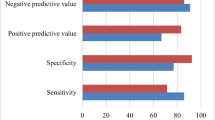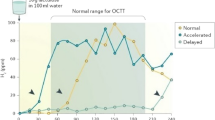Abstract
The bile acid breath test was studied to examine its sensitivity for establishing the diagnosis of bacterial overgrowth in comparison to that of the Schilling test and small-intestinal cultures in 12 patients with a stagnant (blind) loop syndrome, as well as in 38 patients who had other conditions with suspected bacterial contamination of the small intestine. The presence of bile acid malabsorption was excluded in all 50 patients by studies of fecal excretion of radioactively labeled bile acids. The bile acid breath test was positive in 100% (12/12) of the patients with a stagnant (blind) loop syndrome, whereas 92% (11/12) had a positive Schilling test and 75% (9/12) a positive small-intestinal culture. The abnormal tests improved only in 2 of 4 patients treated with tetracycline. In the group of 38 patients without demonstrable dilated or blind loops of small bowel who were suspected of having bacterial contamination of small bowel, the bile acid breath test was positive in 53% (20/38), the Schilling test in 39% (15/38), and the small-intestinal culture in 45% (17/38). The difference in the incidence of positive results between the tests in the two patient groups was statistically not significant. The findings of these studies have the following diagnostic implications: (1) Bile acid breath test, Schilling test, and cultures of aspirates from the upper small bowel are of comparable sensitivity in the detection of bacterial overgrowth in the small intestine. (2) A negative bile acid breath test makes the diagnosis of a stagnant (blind) loop syndrome very unlikely.
Similar content being viewed by others
References
Fromm H, Hofmann AF: Breath test for altered bile acid metabolism. Lancet 2:621–625, 1971
Sherr HP, Sasaki Y, Newman A, Banwell JG, Wagner HN, Jr, Hendrix TR: Detection of bacterial deconjugation of bile salts by a convenient breath-analysis technic. N Engl J Med 285:656–661, 1971
Hörchner P, van Blankenstein M, Boot J, Frenkel M, deGroot R, Hoyset T, Jacobs EP, Looy AJ: Detection of bile acid loss by means of labelled bile acids. Folia Med Neerl 15:186–190, 1972
Fromm H, Thomas PJ, Hofmann AF: Sensitivity and specificity in tests of distal ileal function: Prospective comparison of bile acid and vitamin B12 absorption in ileal resection patients. Gastroenterology 64:1077–1090, 1973
Gray GM: Maldigestion and malabsorption: Clinical manifestations and specific diagnosis. Gastrointestinal Disease, MH Sleisenger, JS Fordtran (eds), Philadelphia, W.B. Saunders, 1973, pp 259–279
Pedersen L, Arnfred T, Hess Thaysen E: Rapid screening of increased bile acid deconjugation and bile acid malabsorption by means of the glycine-1-14C cholylglycine assay. Scand J Gastroenterol 8:665–672, 1973
James OFW, Agnew JE, Bouchier IAD: Assessment of the14C-glycocholic acid breath test. Br Med J 3:191–195, 1973
Hepner GW: Breath analysis: gastroenterological applications. Gastroenterology 67:1250–1256, 1974
Lenz K: An evaluation of the “breath test” in Crohn's disease. Scand J Gastroenterol 10:665–671, 1975
Caspary WF, Reimold WV: Clinical significance of the14C-glycocholate breath test in the diagnosis of gastroenterological diseases. Dtsch med Wochenschr 101:353–360, 1976
Roller RJ, Kern F: Minimal bile acid malabsorption and normal bile acid breath tests in cystic fibrosis and acquired pancreatic insufficiency. Gastroenterology 72:661–665, 1977
Schoeller DA, Schneider JF, Solomons NW, Watkins JB, Klein PD: Clinical diagnosis with the stable isotope13C in CO2 breath tests: Methodology and fundamental considerations. J Lab Clin Med 90:412–421, 1977
Solomons NW, Schoeller DA, Wagonfeld JB, Ott D, Rosenberg IH, Klein PD: Application of a stable isotope [13C]-labeled glycocholate breath test to diagnosis of bacterial overgrowth and ileal dysfunction. J Lab Clin Med 90:431–439, 1977
Midtvedt T, Norman A: Bile acid transformations by microbial strains belonging to genera found in intestinal contents. Acta Pathol Microbiol Scand 71:629–638, 1967
Donaldson RM: Studies on the pathogenesis of steatorrhea in the blind loop syndrome. J Clin Invest 44:1815–1825, 1965
Kim YS, Spritz N, Blum M, Terz J, Sherlock P: The role of altered bile acid metabolism in the steatorrhea of experimental blind loop. J Clin Invest 45:956–962, 1966
Tabaqchali S, Hatzioannou, J, Booth CC: Bile salt deconjugation and steatorrhea in patients with the stagnant loop syndrome. Lancet 2:12–16, 1968
Fromm H, Hofmann AF: The importance of bile acids in human diseases. Erg Inn Med Kinderheilk 37:144–192, 1975
Dietschy JM, Salomon HS, Siperstein MD: Bile acid metabolism. 1. Studies on the mechanisms of intestinal transport. J Clin Invest 45:832–846, 1966
Gorbach SL, Plaut AG, Nahas L, Weinstein L, Spanknebel G, Levitan R: Studies of intestinal microflora: II. Microorganisms of the small intestine and their relation to oral and fecal flora. Gastroenterology 53:856–867, 1967
Winchell HS, Stahelin H, Kusubov N: Kinetics of CO2−HCO3 in normal adult males. J Nucl Med 11:711–715, 1970
Parkin DM, O'Moore RR, Cussons DJ, Warwick RRG, Rooney P, Percy-Robb IW, Shearman DJC: Evaluation of the “breath test” in the detection of bacterial colonization of the upper gastrointestinal tract. Lancet 2:777–780, 1972
Gorbach SL: Bacterial overgrowth and the blind loop syndrome. Disorders of the Gastrointestinal Tract, Disorders of the Liver, Nutritional Disorders. JM Dietschy (ed), New York, Grune & Stratton, 1976, pp 137–138
Dixon WJ, Massey FJ Jr: Introduction to statistical analysis. New York, McGraw-Hill, 1969
Kahn IJ, Jeffries GH, Sleisenger MH: Malabsorption in intestinal scleroderma. Correction by antibiotics. N Engl J Med 274:1334–1344, 1966
Donaldson RM, Jr: Pathogenesis of the blind-loop syndrome. Viewpoints on Digestive Diseases 1, 4, 1969
Gorbach SL: Intestinal microflora. Gastroenterology 60:1110–1129, 1971
Lauterburg BH, Newcomer AD, Hofmann AF: Clinical value of the bile acid breath test. Evaluation of the Mayo Clinic experience. Mayo Clin Proc 53:227–233, 1978
Shindo K, Fukushima K: Deconjugation of bile acids by human intestinal bacteria. Gastroenterol Jpn 11:167–174, 1976
Author information
Authors and Affiliations
Additional information
Dr. Fromm is the recipient of Research Career Development Award AM-00290 from the National Institute of Arthritis, Metabolism and Digestive Diseases
This study was supported by research grant S-31 from the United Way Health Research and Services Foundation and by research grant Fr. 326-2 from the Deutsche Forschungsgemeinschaft.
Rights and permissions
About this article
Cite this article
Farivar, S., Fromm, H., Schindler, D. et al. Sensitivity of bile acid breath test in the diagnosis of bacterial overgrowth in the small intestine with and without the stagnant (blind) loop syndrome. Digest Dis Sci 24, 33–40 (1979). https://doi.org/10.1007/BF01297235
Issue Date:
DOI: https://doi.org/10.1007/BF01297235




